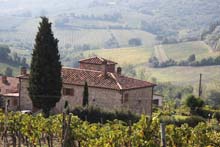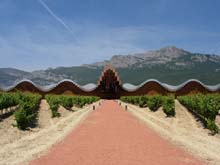Enotourism
In the last years, there has been a deep renewal of the concept of a wine cellar; wine cellars all over Spain are being rebuilt and enhanced for a new project they are putting into practice. This project is the idea of enotourism, or the tourism of wine. For this, the cellar owners have recently discovered that a good change in looks and design will also attract more potential customers or simple weekenders that want a different tourist experience.
Of course, there are many other factors that matter, as is for example the name of the cellar, which is identified by the experts and customers with the make and quality of the wine. Also a good and varied wine offer is definitely as must-have for any cellar that wants to attract visitors and lead this new idea of rural tourism.

The possibilities are endless: from a short visit to the cellar to a whole week of wine-related activities including tastings, courses for sommeliers, wine baths and retreats or residential weekends. Amongst these, there are many wine cellars in Spain that have decided to go into this type of tourism to expand their activities and offer their clients some extras. Not only that, but it is also an attempt to attract more people to the wine world, that has sometimes been identified with class and elites, and the wine producers want to present as a daily product that anyone can learn to enjoy and know.
Also, the rising competitiveness between producers, denominations, quality regions and countries has brought the producers of wine to invent new ways of carrying out their business as well as enhancing, furthering, and differentiating it from those of their competitors.
Of course, you can visit many different cellars that organize these events, but there is a new plus that has got into fashion in the past years. This plus is an original, elegant, modern and provocative restoration and rebuilding of the wine cellars’ buildings by renowned architects from all over the world. This is so for two different purposes: first, add an architectural extra to the whole visit experience, and create a contrast between the wines –an ancient product that has been produced since the early times of mankind-, and the modern XXI century buildings that contain the cellars. This also comes to signify that the Spanish wine culture and its surrounding world have definitely entered modernity and are ready for their trip into the future.
Of these cellars, the most representative ones in Spain are the following:
- Protos: located in the Valladolid province, these producers of one of the finest Ribera de Duero wines have had their cellar rebuilt and altered by the architect Richard Rogers.
- 14 viñas: the prestigious bureau Sancho Madridejos has been in charge of the improvements and alteration of this “manchego” wine producers’ cellar, creating a spectacular aluminium and concrete building that stands out in the middle of the wine region it occupies.
- Cepa 21: Alberto Sáinz de Aja del Moral and José Manuel Barrio Eguíluz are the architects that have been commissioned the restructure of this cellar in Castrillo de Duero, Valladolid, also in the Ribera de Duero DO region.
- Ysios: the famous architect Santiago Calatrava was in charge of the construction of this cellar, a pioneer in the Rioja area of this new trend of “author cellars”, avant-garde buildings and constructions that want to serve as a temple for wine and the wine culture. The impressive design reminds the keen observer of some of the buildings in Gaudi’s Parc Güell in Barcelona.
- Marqués de Riscal: designed by Frank Gehry, who also designed the famous building for the Guggenheim Museum in Bilbao, this is one of the main cellars for the enotourism culture in the Rioja region, more specifically in Álava.
- Baigorri: this concrete building in Samaniego presents a more industrialised and sturdy construction that offers tastings and meals to the visitor.
- Viña Real: also in the Rioja region of Álava, this spectacular building was remodelled by appointment by Philippe Mazières.
- López de Heredia: the breathtaking building created by Zaha Hadid in Haro, La Rioja, houses one of the finest cellars in the Rioja region, and will delight the enotourist like no other.

So remember, if you are a wine lover and are planning to learn Spanish in Spain, don’t hesitate and visit one of these state of the art cellars.
Spanish Wine History
Spanish Wine Regions and DO
Spanish Wine Tours
Top Spanish designations of origin
Best Spanish Wines
Spanish Wine Production
Spanish Wine Types
Spanish Grapes
Spanish Sparkling Wine: Cava
Sherry Wine
Spanish Wine Cocktails
Spanish Wines in the World
Spanish Wine Prizes
Enotourism
Spanish spirits and liquors
Argentina Wines
Chilean Wines
Other sites